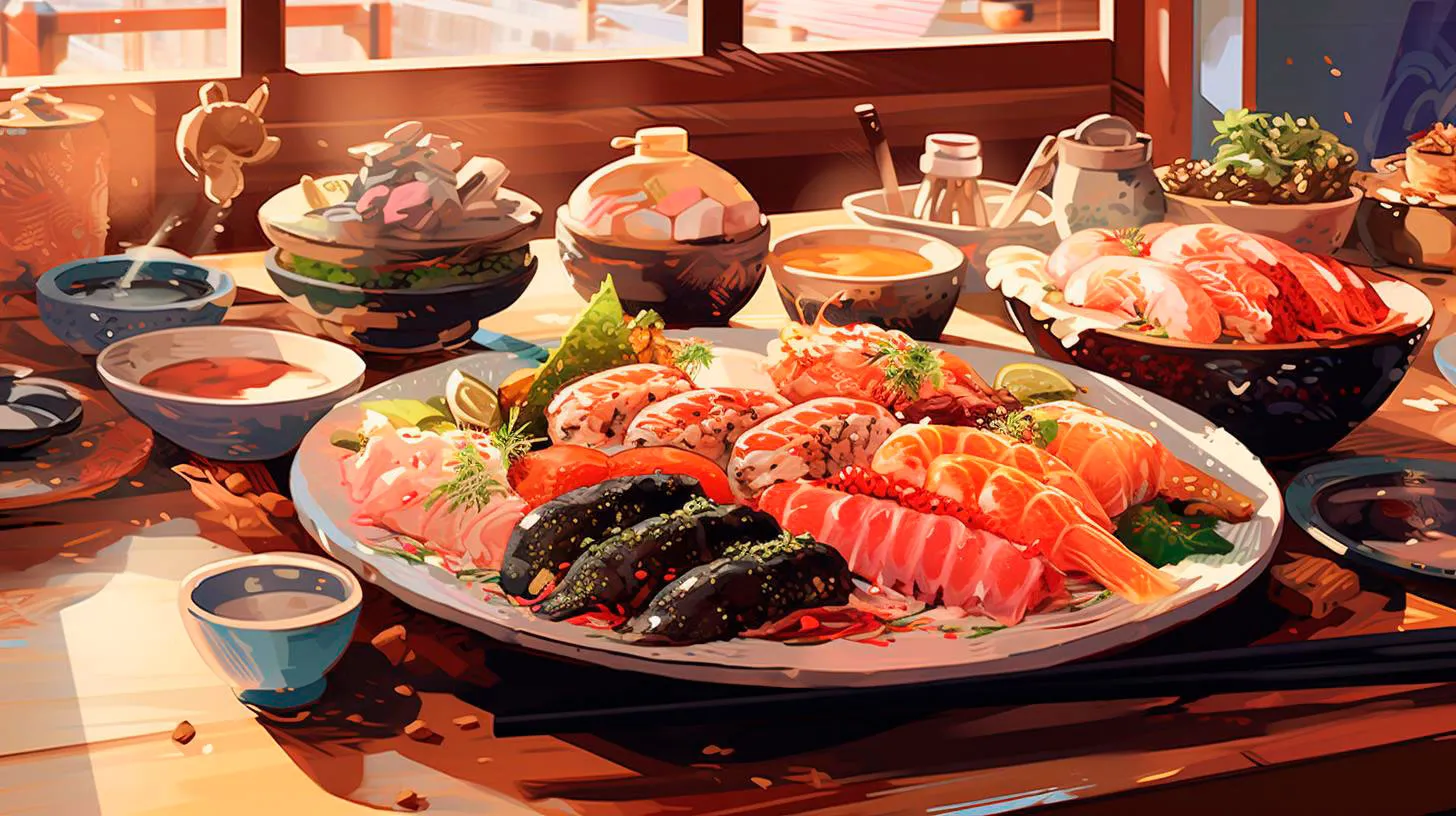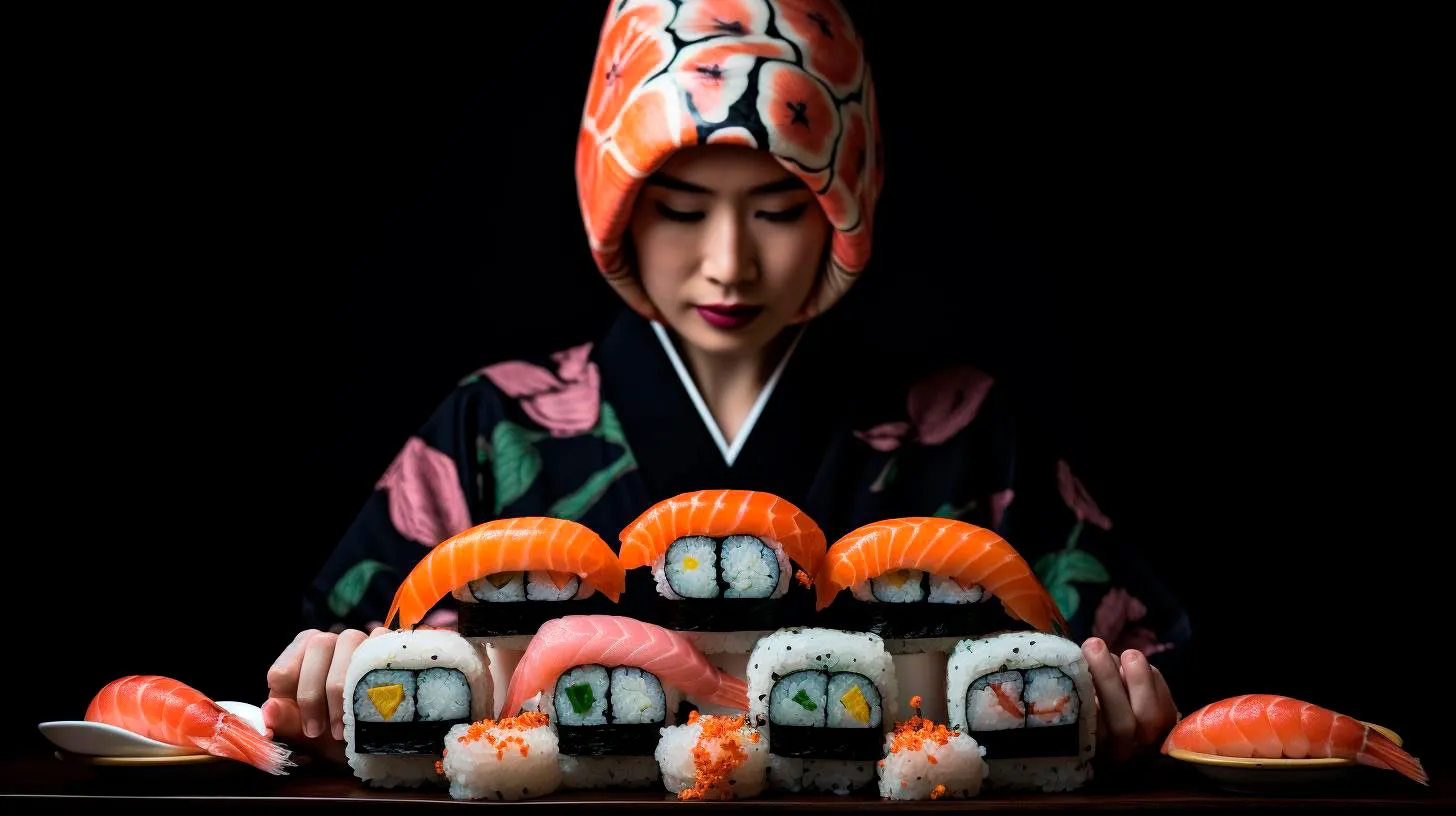A Taste of Japan: Discovering the Art of Sushi
In this article, we will take a closer look at the history, techniques, and cultural significance of sushi, as well as explore the various types of sushi and the art of sushi-making.
The History of Sushi
The origins of sushi can be traced back to ancient Japan, where it was initially developed as a means to preserve fish. The process of fermenting rice with fish and salt created a unique and flavorful dish that could be preserved for long periods. Over time, sushi evolved from a preservation technique to a delicacy enjoyed by the Japanese elite.
However, it wasn’t until the early 19th century that sushi started gaining popularity outside of Japan. In the late 1800s, sushi stalls began to appear on the streets of Tokyo, making it accessible to the masses. Eventually, sushi restaurants started popping up around the world, introducing this exquisite Japanese cuisine to a global audience.
The Art of Sushi-Making
Sushi-making is an art form that requires years of practice and expertise. From selecting the freshest ingredients to mastering the techniques of cutting, shaping, and seasoning, sushi chefs aim to create a harmonious blend of flavors, colors, and textures. The artistry lies not only in the finished product but also in the meticulous attention to detail throughout the entire process.
Here are some key techniques utilized in the art of sushi-making:
- Nigiri: This technique involves shaping bite-sized rice mounds by hand and topping them with raw or cooked fish or seafood.
- Maki: Maki sushi consists of sushi rice and various fillings rolled in seaweed (nori) and sliced into bite-sized pieces. It is commonly known as sushi rolls.
- Sashimi: While not technically sushi, sashimi is a crucial component of Japanese cuisine. It refers to thin slices of raw fish or seafood, served without rice.
The Types of Sushi
Sushi comes in a wide variety of forms, each with its unique flavors and presentations. Here are some popular types of sushi:
- Nigiri: As mentioned earlier, nigiri is a hand-pressed mound of sushi rice topped with a slice of raw or cooked fish or seafood.
- Sashimi: Often served as an appetizer, sashimi consists of thinly sliced raw fish or seafood, showcasing the natural flavors of the ingredients.
- Maki: Maki sushi is created by rolling sushi rice, fillings, and seaweed together, resulting in cylindrical-shaped rolls. Common variations include California rolls, spicy tuna rolls, and tempura rolls.
- Temaki: Temaki sushi is similar to maki, but instead of being sliced into bite-sized pieces, it is served as a hand-rolled cone shape, filled with an assortment of ingredients.
Cultural Significance of Sushi
Sushi is more than just a delicious Japanese cuisine; it embodies the essence of Japanese culture. Here are some reasons why sushi holds cultural significance:
- Japanese Tradition: Sushi reflects the traditions and values of Japan, emphasizing simplicity, balance, and respect for natural ingredients.
- Seasonal Delights: Sushi relies heavily on seasonal ingredients, ensuring that the freshest and finest produce is used to create each dish.
- Social Bonding: In Japan, sushi is often enjoyed in a communal setting, where friends, family, or colleagues gather to share a meal, fostering bonds and relationships.
Key Takeaways
As we delve into the art of sushi-making, it becomes evident that sushi is more than just a meal. It is an embodiment of Japanese culture, precision, and passion for culinary excellence. Here are some key takeaways:
- Sushi originated in Japan and has now become a global culinary sensation.
- The art of sushi-making requires years of practice and expertise.
- Nigiri, maki, and sashimi are some of the fundamental techniques and types of sushi.
- Sushi is deeply rooted in Japanese culture and represents the country’s traditions and values.
Whether you are a sushi aficionado or a curious newcomer, exploring the art of sushi is a true feast for the senses. It allows us to appreciate the delicate balance of flavors, the meticulous craftsmanship, and the cultural significance behind this iconic Japanese dish.
Sushi Beyond Borders: Exploring Fusion Flavors and Techniques
In this article, we will explore the world of fusion sushi and how it has captivated the taste buds of sushi lovers worldwide.
The Rise of Fusion Sushi
As the world becomes more connected, culinary traditions are no longer confined to their country of origin. Chefs around the globe are experimenting with different ingredients, flavors, and techniques to create innovative culinary experiences, and sushi is no exception. Fusion sushi combines the art of Japanese sushi-making with the vibrant flavors of various cuisines, resulting in a delightful blend of flavors and textures.
This fusion of flavors and techniques has opened up a world of possibilities for sushi lovers. Traditional sushi rolls are now infused with ingredients like avocado, cream cheese, and even tropical fruits. Chefs have also started incorporating cooking techniques from other cuisines, such as grilling the fish before placing it on the sushi roll, adding a smoky flavor to the dish.
The Advantages of Fusion Sushi
1. Diverse Flavor Profiles: Fusion sushi provides a whole new range of flavors, allowing sushi lovers to explore unique taste combinations. From spicy tuna rolls with a hint of chipotle to teriyaki chicken sushi topped with tangy pineapple salsa, the possibilities are endless.
2. Accessibility: Fusion sushi has made the traditional Japanese dish more accessible to a broader audience. By incorporating familiar ingredients and flavors, it appeals to those who may not be accustomed to traditional sushi but are still looking for a sushi-like experience.
3. Innovation and Creativity: Fusion sushi is a playground for culinary creativity. Chefs are constantly experimenting with new ingredient combinations, presentation styles, and cooking techniques to create visually stunning and delicious sushi creations.
Key Takeaways for Sushi Lovers
1. Embrace the Fusion: Don’t be afraid to try out new and exciting sushi combinations. Whether it’s a fusion roll with unique ingredients or a traditional roll with a twist, be open to exploring different flavors and techniques.
2. Appreciate the Craftsmanship: Fusion sushi requires skill and creativity from the chefs. Take a moment to admire the artistry and attention to detail that goes into creating each dish.
3. Keep an Eye Out for Specials: Many sushi restaurants offer daily or weekly specials featuring fusion sushi creations. Stay updated with their menus to discover new and limited-time offerings.
Exploring the Global Sushi Scene
Sushi’s journey beyond borders has not been limited to just one region. Let’s take a quick look at how different cultures have embraced fusion sushi:
1. United States:
The United States has been at the forefront of the fusion sushi trend. California rolls, made with avocado, crab meat, and cucumber, are a popular example of fusion sushi that originated in the U.S. Many American sushi restaurants continue to innovate and create unique rolls influenced by a variety of cuisines.
2. Latin America:
In Latin America, fusion sushi has taken on a distinctive twist. Sushi rolls are often topped with tangy ceviche or accompanied by avocado and tropical fruits, blending traditional Japanese flavors with the vibrant and bold tastes of Latin America.
3. Europe:
Europe has also embraced fusion sushi, adding their own local flavors to the mix. Sushi rolls with smoked salmon, dill, and capers pay homage to the classic flavors of Scandinavian cuisine, while sushi rolls with cream cheese and smoked eel draw inspiration from Eastern European delicacies.
4. Southeast Asia:
In Southeast Asia, fusion sushi blends the delicate flavors of Japanese cuisine with local herbs, spices, and seafood. Thai basil, lemongrass, and chili-infused sauces are just a few examples of the unique flavors found in fusion sushi in this region.
Whether you’re a traditionalist or an adventurous foodie, fusion sushi offers a world of flavors and techniques worth exploring. Embrace the fusion, savor the creativity, and experience sushi beyond borders!
From Classic Rolls to Creative Maki: Unleashing Sushi Potential
A Brief History of Sushi
Sushi originated in ancient China around the 2nd century AD but was later introduced to Japan in the 8th century. Initially, sushi was a preservation technique where fish was fermented with rice and consumed after a few months. This method allowed fish to be stored for extended periods, facilitating the growth of a thriving sushi industry. Over time, the fermentation process evolved into pickling, and then eventually transformed into the sushi we know today.
The sushi we consume today can be attributed to the creative genius of Yohei Hanaya, a Japanese chef from the early 19th century. Hanaya revolutionized sushi by replacing fermented fish with fresh fish and incorporating vinegared rice, creating a more palatable combination. This innovation laid the foundation for modern sushi.
Types of Sushi
1. Nigiri:
Nigiri sushi consists of a small, hand-pressed mound of rice topped with a slice of fresh fish or seafood. Some key points to note about nigiri sushi include:
- Popular fish toppings include tuna, salmon, and shrimp.
- Wasabi, a spicy Japanese horseradish, is usually placed between the rice and fish.
- Soy sauce and ginger are common accompaniments.
2. Maki:
Maki sushi is made by rolling ingredients such as fish, vegetables, and rice in a sheet of seaweed called nori. Some notable characteristics of maki sushi are:
- There are various types of maki rolls, including the classic California roll and the spicy tuna roll.
- The nori serves as a wrapper, enclosing the ingredients inside.
- Maki rolls are typically sliced into bite-sized pieces before serving.
3. Sashimi:
Unlike other types of sushi, sashimi does not include rice. It consists of thinly sliced raw fish or seafood served as a standalone dish. Key features of sashimi include:
- The freshness and quality of the fish are crucial for sashimi.
- Common fish used for sashimi include yellowtail, salmon, and tuna.
- Sashimi is often garnished with daikon radish, shiso leaves, and soy sauce.
Sushi’s Global Popularity
Over the years, the popularity of sushi has transcended cultural boundaries and can now be found in almost every corner of the world. Here are some reasons why sushi has become a global phenomenon:
- Health benefits: Sushi offers a nutritious dining option. Fish, a primary ingredient in sushi, is a significant source of omega-3 fatty acids and essential vitamins.
- Creativity and customization: Sushi allows chefs and diners to experiment with various ingredients, resulting in fusion rolls and innovative flavor combinations.
- Convenience: Sushi’s easy-to-eat nature makes it a great choice for on-the-go meals or quick lunches.
According to recent statistics, the global sushi market was valued at $14.3 billion in 2020 and is projected to reach $24.5 billion by 2027. These figures reflect the increasing demand and growing consumer interest in sushi worldwide.
Key Takeaways
- Sushi has a rich history that dates back centuries.
- There are various types of sushi, including nigiri, maki, and sashimi, each with distinct characteristics.
- Sushi has gained popularity globally due to its health benefits, customization options, and convenience.
- The global sushi market is projected to grow significantly in the coming years.
Next time you indulge in a sushi feast, take a moment to appreciate the culinary journey that brought this delightful dish to your plate. From classic nigiri to creative maki rolls, sushi continues to evolve, offering endless possibilities for both traditionalists and adventurers in search of new flavors.
Savoring Tranquility: How Sushi Elevates the Dining Experience
In this article, we will explore the key aspects that make sushi a truly exceptional dining choice.
The Art of Sushi
Sushi is not just a dish; it is an art form. Skilled sushi chefs delicately craft each sushi roll, paying attention to every detail. Whether it’s a traditional nigiri or a creative maki roll, sushi is visually appealing and a treat for the senses. The careful placement of colorful ingredients and the elegant presentation on a beautiful platter showcase the chef’s expertise and artistic flair.
Key takeaway: Sushi is a culinary masterpiece that pleases both the eyes and the palate.
A Symphony of Flavors
One of the reasons why sushi has gained worldwide popularity is its delightful combination of flavors. From the freshness of raw fish to the creaminess of avocado and the tanginess of pickled ginger, each bite offers a symphony of flavors that dance on your taste buds. The subtle balance of sweet, salty, sour, and umami flavors creates a harmonious experience that is truly unique to sushi.
Key takeaway: Sushi is a flavor adventure that tantalizes the taste buds with its diverse and delicate flavors.
A Healthy Delight
In addition to its culinary artistry, sushi is renowned for its health benefits. With its emphasis on fresh fish, vegetables, and whole ingredients, sushi offers a nutritious and balanced meal. It is low in fat, high in protein, and packed with vitamins and minerals. The omega-3 fatty acids found in fish such as salmon and tuna contribute to heart health and brain function. Moreover, sushi rice provides a good source of carbohydrates for energy.
Key takeaway: Sushi is a guilt-free indulgence that nourishes the body and supports overall well-being.
An Interactive Experience
Sushi dining goes beyond merely consuming food; it is an interactive experience that engages all your senses. Whether you’re sitting at the sushi bar or a traditional dining table, you have a front-row seat to watch the skilled sushi chef prepare your meal. The chef’s precision knife work and attention to detail are awe-inspiring. Guests also have the opportunity to engage in conversation and learn more about the ingredients and techniques used in sushi making.
Key takeaway: Sushi dining is a social and interactive experience that creates a memorable and engaging atmosphere.
An Elegant Escape
Stepping into a sushi restaurant often feels like entering another world— a tranquil escape from the chaos of everyday life. The minimalist decor, soothing ambiance, and meticulous attention to detail create an atmosphere of serenity. Sushi restaurants focus on creating a space where customers can relax and savor their dining experience fully.
Key takeaway: Sushi restaurants offer a serene and refined environment, allowing diners to unwind and enjoy their meal to the fullest.
In Conclusion
Whether you’re a sushi connoisseur or new to the world of Japanese cuisine, there’s no denying the unique dining experience that sushi offers. From its artistic presentation to its diverse flavors, sushi elevates the act of eating into a true sensory delight. The next time you’re in the mood for an extraordinary dining experience, be sure to savor the tranquility of sushi.
Remember to choose sushi restaurants that showcase the artistry of their dishes, opt for fresh and high-quality ingredients, and enjoy the interactive process of sushi making. Your taste buds and overall well-being will thank you for it! Dive into the world of sushi and unlock a whole new level of dining pleasure.


